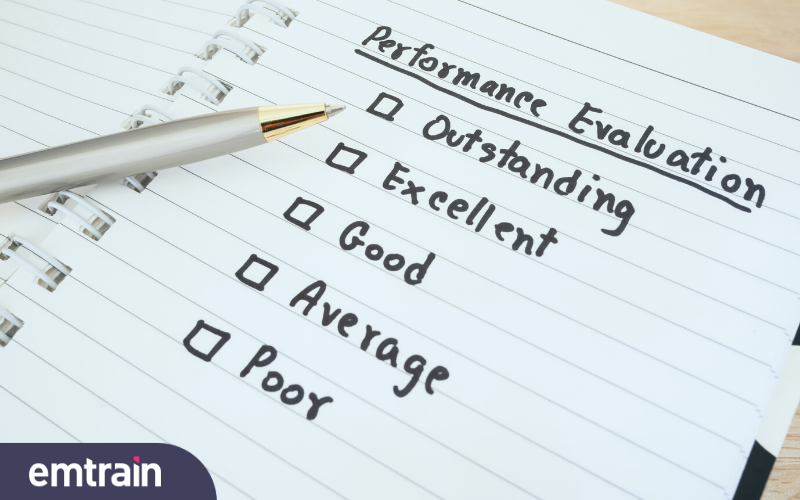It’s a late Thursday afternoon, and you’re scrambling to finish your quarterly business report to present to your executives the next morning. Suddenly, a Slack message pops up in the Company-Wide channel, “Managers, make sure you’ve completed your annual performance review with your employees. The deadline to submit reviews on Lattice is Friday EOD.”
Some of your employees are sending you Slack messages about their performance reviews. You’re in panic mode because you realized you didn’t prepare for your employee performance review. Then, when you meet with your employees one-on-one, you find yourself struggling to bring in examples of their work, discuss strengths and areas of weakness, and forget specific objectives you both agreed upon at the beginning of the year.

The annual performance review requires preparation to conduct a constructive performance review that’s beneficial to you and your employee. Although the year is almost over, and whether you and your company have already conducted performance reviews or are in the process, you can start thinking about prepping for next year. We’ve compiled six rules to keep you ahead and ready for a rock star performance review.
6 Ways in How to Prepare for a Year End Performance Review
-
Focus on performance only
As a first step, review your employee’s job description, goals, and objectives to help you focus on what the expectations were for that employee and how their performance relates to those expectations. Assessing their actual performance will help you jumpstart the process and can put any predisposed notions of general performance in perspective.
-
Use objective criteria
Ensure your evaluations are both skills-based and results-based by using objective criteria. Remember, you are evaluating your employee’s performance, not the employee. So, when preparing their evaluation, avoid assessing individual personal characteristics, such as attitude and personality. Instead, focus on the employee’s actions, skills, and behavior, and how their conduct resulted in achieving or not achieving their objectives. For example, instead of stating, “Joe’s negativity makes it difficult for him to get along with his co-workers” state, “Joe’s teamwork skills need development. Joe could improve by working more cooperatively with his co-workers and being more accepting of their ideas and contributions.” The use of subjective criteria in an evaluation can also create a risk that managers may unconsciously judge employees based on characteristics that are not related to actual job duties or performance, but, rather, on impermissible traits such as their gender, race, or other unlawful criteria.
-
Acknowledge perfections and imperfections
As a manager, nothing is more exciting than getting the opportunity to commend excellent performance. Acknowledge their achievements, how they’ve exceeded objectives or performance standards, and document them in your written review. Also, you want to be honest about your employee’s performance. Avoid sugar coating their weaknesses and be specific when pointing out their flaws or deficiencies and which areas they need improvement. If defects are not improved, make sure your employee is aware of the consequences and continue to track their weaknesses until it’s corrected. Otherwise, if you fail to address uncorrected performance deficiencies, your employees will get the wrong impression, leading them to believe that the problem no longer exists.
-
Be fair
If there are extraneous factors that either contribute to or detract from the employee’s achievement of objectives, include those factors in the review. For example, if an employee was not able to meet specific objectives due to other unforeseen priorities you assigned to your employee, that fact should be included in the evaluation and taken into consideration when rating the employee on that objective.
-
Provide written comments
Avoid the use of generic pre-printed forms that do not allow room for written comments. Although it’s fine to use a “check the box” evaluation form, your rating must still be supported by written comments which illustrate and provide detail to support your rating. Ensure your written comments are consistent with your rating by first drafting your commentary, then going back and check-marking the applicable rating.
-
Be consistent
The same standards applied to other employees should refer to the employee you’re reviewing. Are other employees who are exhibiting the same performance deficiencies rated similarly? Employees who feel they are being calculated unfairly or inconsistently with their peers are more likely to challenge their evaluation. Ensure that performance standards are applied consistently to all employees to help your company avoid or win lawsuits.
By keeping these 6 simple rules in mind, you’ll be able to conduct an effective performance review for your employees, making ou an effective manager. To learn more about evaluating your employee’s performance during the annual review, check out Emtrain’s latest guide: The Manager’s Guide to Performance Management: How to Give Your Employee a Constructive Evaluation.











